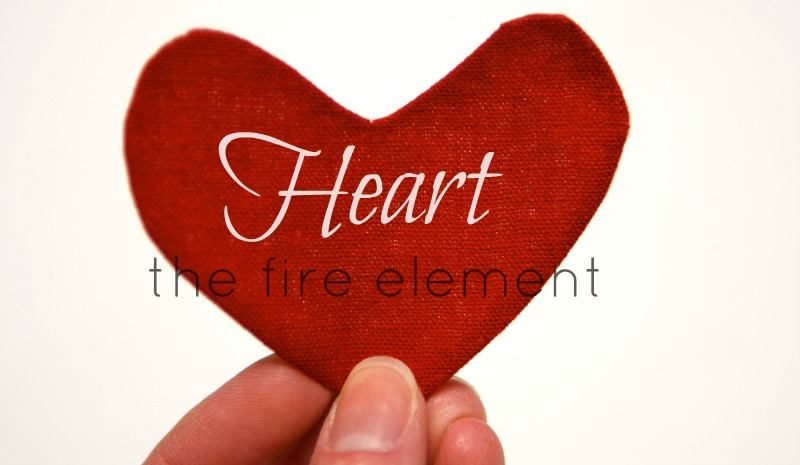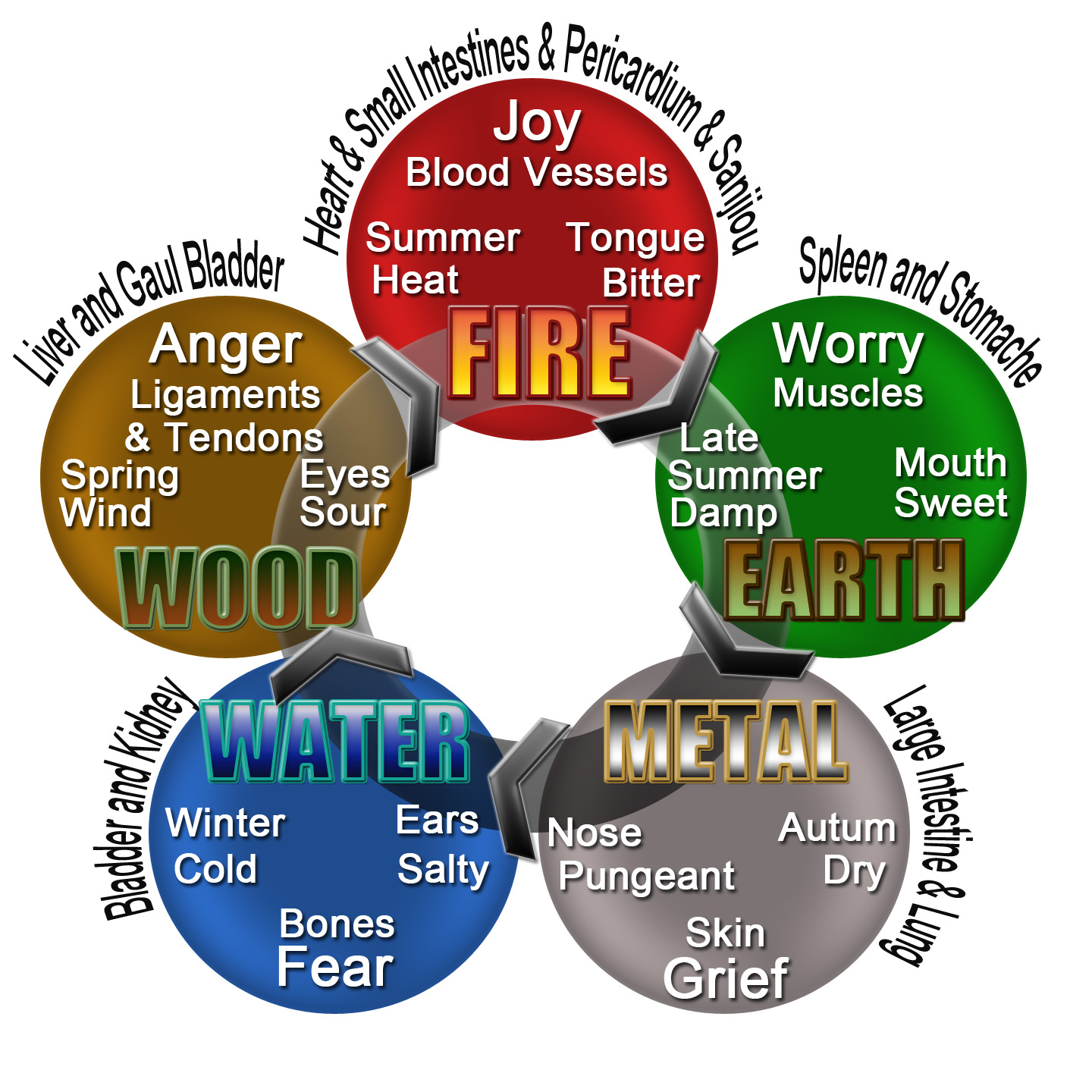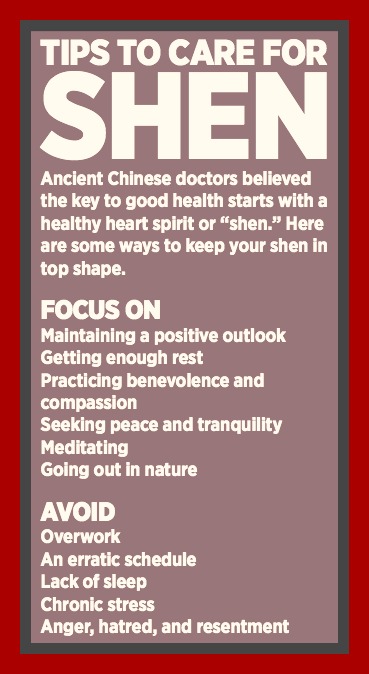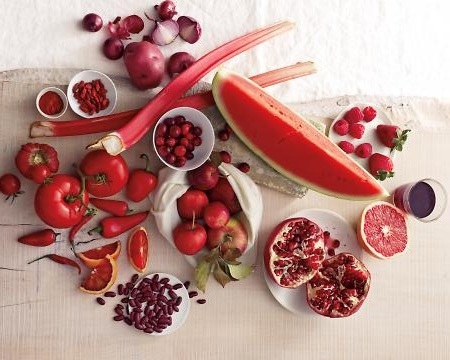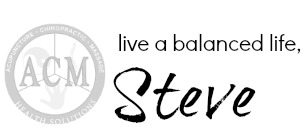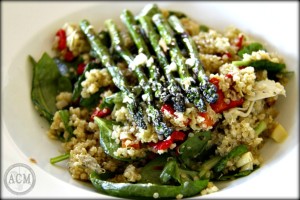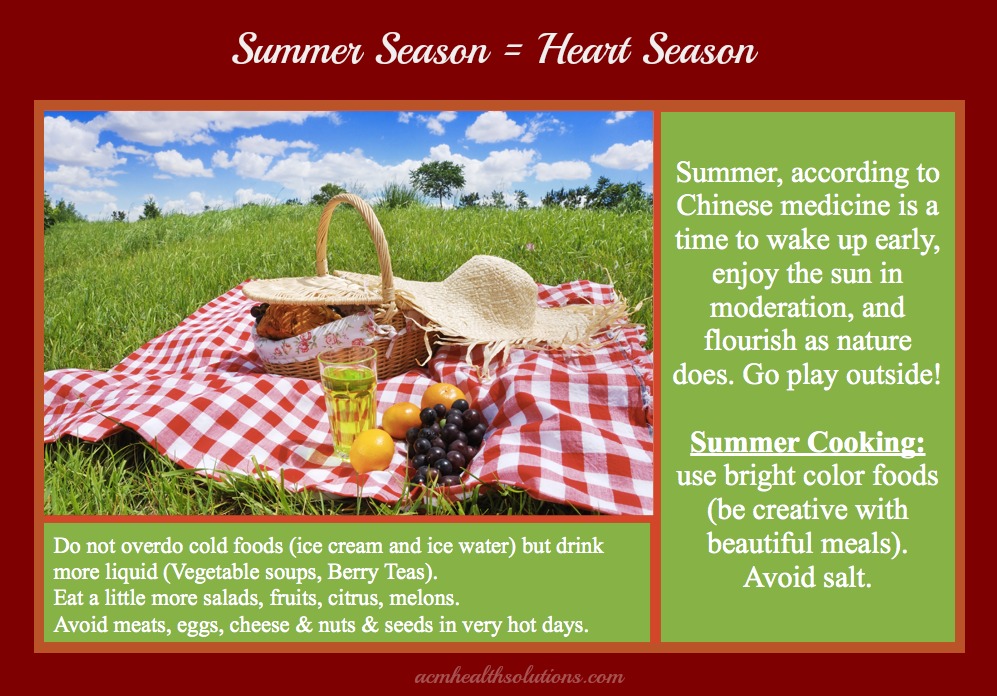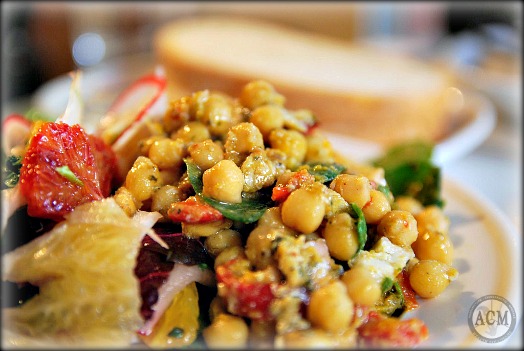-
Book Online Now - Acupuncture Solutions3900 Pebblecreek Ct #101
Plano, TX 75023972-612-4900 - 6501 Wesley St #A-1
Greenville, TX 75402903-213-3679 Learn more about…
#autumn #balance #behappy #fall #familytime #germs #healthlyliving #healthyskin #immunesystem #organs #psoriasis #seasons #sunscreen #thinkpositive acupressure acupuncture allergies anxiety coronavirus covid-19 depression diet digestion energy exercise headaches health heart herbs kidneys liver lungs meditation migraines nutrition pain pms qi sleep spring stress summer tcm Traditional Chinese Medicine winter
Summer
Heart A’fire: The Fire Element
The organs in Chinese medicine are more than just a physical representation. The organs include not only their physiological function, but also their mental, emotional, spiritual and elemental qualities that align with nature and the seasons. Let’s explore the heart.
The heart season is summer, and heart is considered the most yang: hot, bountiful and abundant. Yang is what is bright, moving, outward, hot and loud. Yin is what is more inward, still, dark and cooler. The color of the heart is associated with red, the climate is heat, the flavor is bitter and it’s paired organ is the small intestine (many urinary issues are due to “heart fire” heat descending). The sense aligned with heart is the tongue, and the vessels associated with heart are the tissues. The heart sound is laughing, and the emotion is joy. The heart houses what is known as the shen, which is the mind and spirit. You can see a person’s shen in a healthy complexion and radiant eyes that are clear and bright. The heart is in charge of circulation and keeps the tissues well nourished. It is also associated with mental clarity, memory and strength. The motion of this fire element is upward, like a flame. Many who have this element dominant in their personality have red hair that is curly or spikes upward. The heart is also connected to speech. An imbalance in heart energy can result in stuttering, speaking excitedly or talking excessively.
A healthy heart energy exudes a sense of joy, fun, enthusiasm, action, warmth, and charisma. These people are the “life of the party,” and love to have a good time with friends and to be the center of attention. When the heart is balanced, sleep is sound and one is well rested.
On the other hand, when there is an overabundance of fire this can result in restlessness, anxiety, sweating, excitability and symptoms such as palpitations, irregular heartbeat, insomnia, disturbing dreams, mouth sores, thirst, red face, constipation and dryness. This person might shrink if not in the limelight and would constantly seek attention and need activities that produce a lot of excitement. He or she might have trouble being introspective and could not be alone. “Overjoy” is an imbalance of heart energy and is likened to manic behavior. A dominant fire may also be extremely sensitive to heat. A lack of the fire element, on the other hand, can result in a lusterless complexion, low energy, inertia, depression, feeling cold, low libido and the personality may lack warmth. This type may seem cold, frigid, lack drive and may be prone to addictions.
How to help your heart stay in balance? Red foods have been shown to help the heart biochemically; foods such as hawthorn berries, strawberries, cherries, raspberries, tomatoes, watermelon, peppers and goji berries keep your heart happy with lycopene and anthocyanin, antioxidants and beneficial vitamins. Other helpful foods include garlic, cayenne, cilantro, basil, magnesium (found in leafy greens, nuts and soy) and green tea. Also try ginseng, jujube dates, reishi mushrooms, dong quai, seaweed and schizandra berries. Calming activities such as walking, tai qi, or qi gong help calm the shen.
It is best not to self-diagnose, so see your healthcare provider to see if those foods are right for you. You don’t want to assume you have too much of one element and end up eating the wrong foods. A Chinese medical specialist can give you a proper diagnosis as far as the Five Element theory goes to see which element is dominant in you, and they can treat your condition with acupuncture, herbs and offer advice for beneficial changes in diet and lifestyle.
Nutrition for Heart Health
Nutrition for Heart Health
Oriental medicine (OM) nutrition combines ancient wisdom with modern science. OM nutrition is a holistic approach, which aims to balance all five flavors within most meals with one or two flavors being emphasized for therapeutic purposes. OM nutrition for a hypertension emphasizes bitter flavors, sour flavors and energetically-cooling foods.
OM theory states the bitter flavor benefits the heart in moderation but an excess is harmful as it has a drying effect; for example, coffee is bitter. In moderation coffee acts as vasodilator, increasing circulation but in excess it can raise blood pressure and has a diuretic effect. Modern scientific research has discovered while the human genome has 25 bitter taste receptors 12 of these are expressed in the human heart.
Foods with bitter flavors include: romaine lettuce, dandelion, arugula, rye. Foods that combine bitter with pungency include: citrus peel, radish, scallion and white pepper. In OM nutrition the pungent flavor can help disperse phlegm (e.g. plaque). Foods that combine bitter with sweet include: asparagus, celery, tomatoes, lettuce, quinoa and papaya. Lemon rind is bitter and sour; vinegar is also bitter and sour.
Bitter flavors have a yin, or cooling effect, clearing heat in the body while encouraging a descent of Qi, which aids in the draining of fluids. For example, celery contains the phytochemical phthalides which relaxes arterial wall tissues to increase blood flow and thereby reduce blood pressure. The fiber, magnesium and potassium in celery also help lower blood pressure and regulate fluid balance. Caution: according to OM, those with a lot of dryness and/or bone disease should moderate their intake of bitter flavor.
A tomato a day keeps the doctor away! The combination of lycopene, vitamin C and E, potassium and folic acid in tomatoes make it a power food for heart health. The bitter flavor of tomatoes come from the seeds; to reap the full benefit of tomatoes eat the seeds too. Heirloom tomatoes in season have the most flavor, find the tastiest tomatoes at your farmer’s market or trying growing your own.
Summer is the season of the heart according to Chinese medicine, meaning it is the season most likely to bring our hearts out of balance if we are exposed to excess heat, which can then create and/or exacerbate internal heat. During the summer OM nutrition recommends drinking and eating foods that cool the body and heart such as green tea, cucumbers, watermelon and lemon.
Chrysanthemum tea is a very popular summertime tea in Asia because it is so well known for its cooling properties; it is helpful for headaches, dizziness, high blood pressure, chest pain and also fevers. You can add chrysanthemum flowers to your morning green tea and in the evening combine it with chamomile tea for extra cooling benefits!
OM nutrition cautions against overdoing cold foods and drinks. Too much cold inhibits the digestive process. Drinking warm beverages and soups, as well as eating foods with a little pungency (chili pepper, garlic, ginger) causes the body to perspire slightly which naturally cools the body.
For those who happen to have hypertension plus a lot of dryness: dry skin, dry eyes, dry mouth and thirst, constipation and even hormonal deficiencies can benefit from increasing their healthy fat intake. Many nutrients are fat soluble, the body uses cholesterol to make hormones, bile and vitamin D. Healthy fats nourish yin in OM nutrition theory. Some Americans who suffer from hypertension are also thin with an underlying yin deficiency, such as those with the onset of hypertension that coincides with menopausal symptoms. Sources of healthy fats include: nuts, seeds, avocado, olive oil, flaxseed oil and fish.
Eating beans, peas and grains are high in potassium, magnesium, fiber and are high in choline which is vital in lowering hypertension and boosting fat metabolism. Whole grains are also a good source of niacin and vitamin E and are recommended for healthy arteries, especially those that are slightly bitter such as: rye, quinoa, amaranth and oats.
Try this OM Nutrition Recipe for Heart Health:
5 Flavors Chickpea Salad for Healthy & Happy Heart
15 oz cooked organic chick peas (1 can)
1/2 c cup cooked quinoa or 1 cup brown rice (warm)
4 stalks celery, minced
6-12 cherry tomatoes, chapped in 1/2 or 1/4
8-12 Romaine lettuce leaves, chopped
2 TBSP red onion, minced
Toss with dressing made with:
2 TBSP olive oil
1 TBSP lemon juice + a little lemon zest (organic is best)
1 tsp grated ginger
1/2 tsp honey or agave
1-2 garlic cloves (minced or pressed)
1/8 tsp Himalayan or Sea salt (or to taste)
fresh ground black pepper (to taste)
Resources
https://health.clevelandclinic.org/2015/04/celery-may-help-bring-your-high-blood-pressure-down/
https://health.clevelandclinic.org/2015/04/celery-may-help-bring-your-high-blood-pressure-down/
Foster, S. R., Blank, K., Hoe, L. E. S., Behrens, M., Meyerhof, W., Peart, J. N., & Thomas, W. G. (2014). Bitter taste receptor agonists elicit G-protein-dependent negative inotropy in the murine heart. The FASEB Journal, 28(10), 4497-4508.
Kastner, Joseph, MD, L.Ac, (2009) Chinese Nutrition Therapy, Thieme, Stuttgart and New York
Pitchford, Paul (2002), Healing with Whole Foods: Asian Traditions and Modern Nutrition, North Atlantic Books, Berkeley, California
Ried, K., Frank, O. R., Stocks, N. P., Fakler, P., & Sullivan, T. (2008). Effect of garlic on blood pressure: a systematic review and meta-analysis. BMC cardiovascular disorders, 8(1), 1.
Willcox, J. K., Catignani, G. L., & Lazarus, S. (2003). Tomatoes and Cardiovascular Health. Critical Reviews in Food Science and Nutrition, 43(1), 1-18.
3 Ways to Prepare For Seasonal Changes
 As the transition from summer to fall begins, changes start to happen externally as well as internally. The days become shorter and the air gets cooler; our bodies change to adapt as well. Here are three ways to prepare for the fall season ahead along with the beginning of the yin cycle.
As the transition from summer to fall begins, changes start to happen externally as well as internally. The days become shorter and the air gets cooler; our bodies change to adapt as well. Here are three ways to prepare for the fall season ahead along with the beginning of the yin cycle.
1. Let go of negativity
The autumn season represents the time when the lungs and large intestine are of the utmost importance. This season is especially an important time to let of negative energy in your life.
Negativity doesn’t just affect your psychological health but your physical health as well. You can help get rid toxicity in your life by being aware of the causes and surrounding yourself with positive energy and people who make you happy.
2. Spend time outside
Because fall is focused on the lungs, spending more time outside can help strengthen this organ and increase your immune system as cold and flu season starts to emerge.
Spend time in nature away from city pollution where you can breathe clean, cool air. Autumn time is the perfect opportunity to do this and refresh and strengthen the lungs.
3. Acupuncture
Acupuncture treatment can help you physically as well as mentally prepare for the change in seasons.
Some find it difficult to let go of the summer season and transition to shorter, cooler days. Acupuncture can ease this transition and make sure your body and energy are flowing properly.
Sources:
Save Your Summertime Skin
 Now is the time of year when the sun becomes irresistible. As tempting as it is to spend as much time as possible in the warmth of the sun, there are a few precautions to take to protect your skin from harmful rays.
Now is the time of year when the sun becomes irresistible. As tempting as it is to spend as much time as possible in the warmth of the sun, there are a few precautions to take to protect your skin from harmful rays.
Our skin is the largest organ in the body. It reflects our health and age. Today, there’s much concern about sunbathing leading to an increase in skin damage and skin cancer.
Excessive exposure to ultraviolet rays can increase the production of free radicals that can adversely affect the integrity of collagen in the skin. Over time, our skin becomes wrinkled, cracked, aged, and brittle. For smokers, the effects are multiplied.
Research suggests that skin cancer is cumulative over a lifetime. It begins with overexposure and serious sunburns during childhood.
We can’t live without the sun. Our bodies require sunlight in order to manufacture Vitamin D needed for calcium absorption, among other things. So, we shouldn’t hide from our shining star. Here are a few helpful tips and precautions to take when you’re soaking in the sun this summer.
Use sunscreen – Choose a sunscreen with a high SPF number for greater protection. Apply it onto your skin 15 minutes before you go outside. Don’t forget your nose, ears, and neck.
Time is key – Avoid sun exposure when the sun is at its highest peak in the sky, typically from about 11:00 am – 4:00 pm.
Gear up – Wear a hat with a wide brim, t-shirt, and sunglasses that filter ultraviolet rays.
Drink up – By keeping your body hydrated you can avoid dehydration and provide moisture for the skin to prevent dryness, cracking, and aging.
Pop a pill – Vitamins such as A, E, and some antioxidants help prevent skin damage from the inside. Cod Liver oil and Flaxseed oil have also been used to support skin health.
Brush it off – Before you take a shower, use a dry skin brush. This can open pores and slough off dead skin, allowing your skin to breathe easily and work more efficiently.
Keep healthy – Some medications we take may have reactions and side effects when we’re exposed to sunlight. Acupuncture may be able to provide an alternative to these medications, keeping you healthy, safely and naturally.
If you want to enjoy the sun this summer season and not worry later, practice good sun sense.
You and your skin deserve it!
Summer Time Fun and Safety
Sun Safety Tips
It’s summertime. It’s time to get outdoors and enjoy the sun.
Follow these sun safety tips to protect your skin and avoid a nasty burn.
- Cover up. Wear clothes and a hat to protect your skin.
- Find shade. Instead of spending all day under the hot, beaming sun, spend part of the day in the shade. If no shade is available, bring an umbrella or tent.
- Avoid the noon sun. Ultraviolet (UV) radiation peaks at noon, when the sun is highest in the sky. Time your fun in the sun for early morning or late afternoon when the sun is less intense.
- Wear sunglasses. Protect your eyes from UV radiation.
- Choose sunscreen wisely. Not all sunscreens are made the same. Use the tips below to pick the best sunscreen.
- Put on sunscreen before getting dressed. If you apply sunscreen around clothes, you may miss a spot.
- Apply sunscreen to all exposed skin—including your part or bald patch. Any skin can burn in the sun.
- Allow 20 minutes between applying sunscreen and going outside. This allows the sunscreen to penetrate the upper epidermis of the skin.
- Buy new sunscreen every year so the ingredients stay fresh and potent.
- Protect children, especially babies, from the sun. Their skin is extremely vulnerable.
Sun Protection Do’s and Don’ts
Do:
- Do use products with zinc, titanium dioxide, avobenzone or Mexoryl SX. These ingredients give good sun protection without penetrating the skin and entering the bloodstream.
- Do use sunscreen creams or lotions.
- Do use broad spectrum protection.
- Do use sunscreens labeled “water resistant for beach, pool and exercise.”
- Do use SPF 30+.
- Do reapply often.
Don’t:
- Don’t use products with vitamin A (retinyl palmitate). Vitamin A is good to eat but studies show it is harmful on your skin.
- Don’t use products with oxybenzone, a synthetic estrogen that can enter the bloodstream through the skin.
- Don’t use sunscreens with added insect repellent. Apply insect repellent separately. Put it on before your sunscreen.
- Don’t use sprays or powders. Sprays and powders release sunscreen particles that may not be safe to breathe.
- Don’t use SPF above 50+. High SPF numbers are misleading. They may tempt you to stay in the sun longer, exposing you to types of skin damage other than sunburn.
